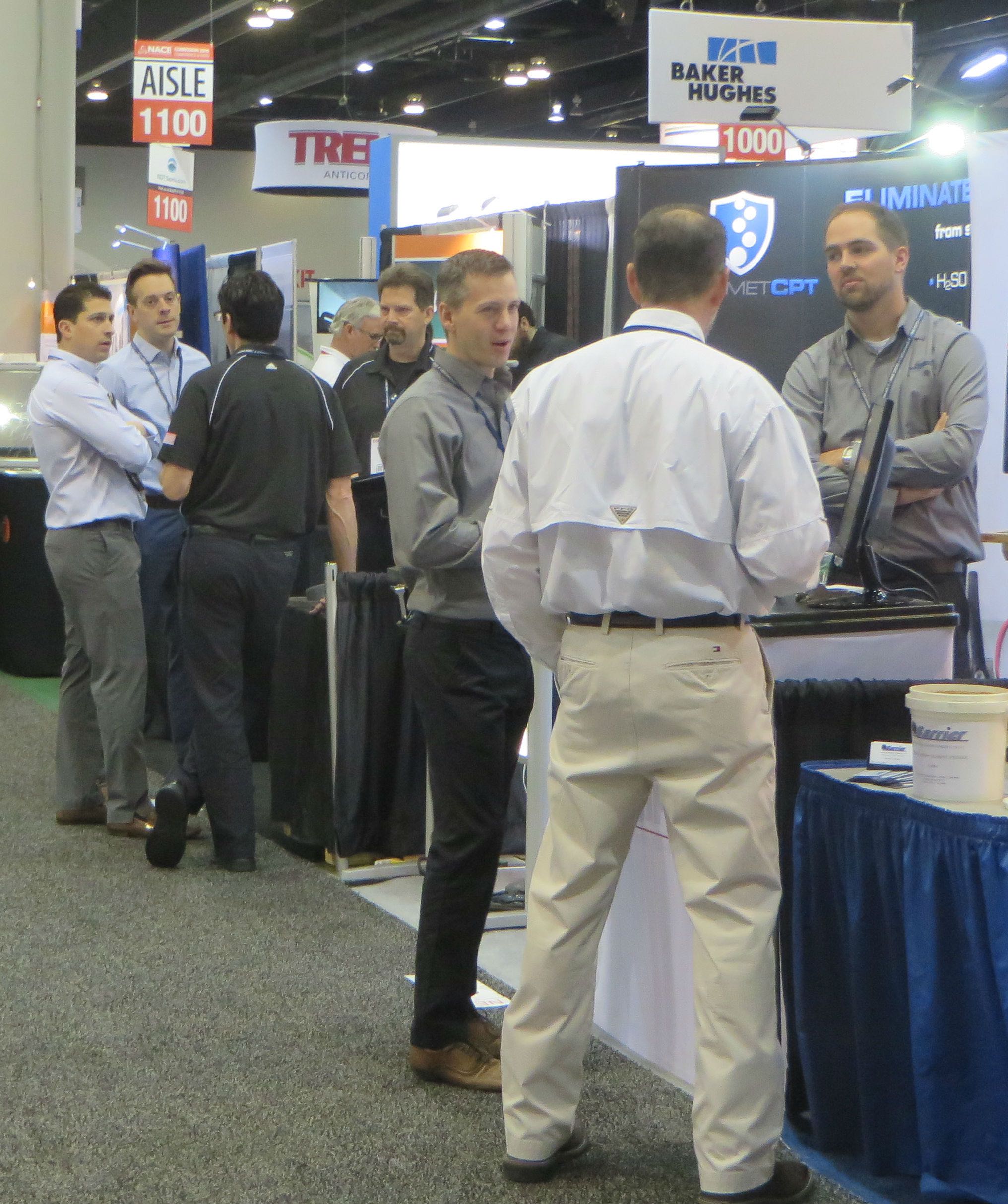June 2016, Vol. 243, No. 6
Features
NACE International Brings the Corrosion Fight to Vancouver, BC

NACE Corrosion 2016, held March 6-10 in Vancouver, B.C., brought together a widely diverse representation of those involved in the coating and anti-corrosion materials fields.
In all about 6,500 attendees whose interests ranged from applications for highway and bridge construction to wastewater projects, spilled into the Vancouver Convention Centre to visit about 350 exhibits, attend technical and research symposia – and, of course, network.
For participants interested in fighting corrosion as it specifically affects the oil and gas industry there was plenty to be seen, too, with at least 260 exhibitors in attendance who listed among their specializations: pipelines, tanks and underground systems, oil and gas exploration, and refining.
“I think for the quality of meetings we’ve been able to arrange this has worked out well for our company,” said Keymay Industries’ Chelsey Reschke, vice president of the Coating Division, whose company hopes to attract interest its new, cleaner coating method. “Also, the international aspect of this event is good for us.”
Expressing similar feelings about the event was Axalta’s Bill Sante, global director of functional coating, who said his company provides virtually all types of coating there is “outside of house paint.”
“This has gone really well for us. It’s a good fit due to the diversity of our product,” he said. “We’ve been happy with the quality of contacts we’ve made here.”
While the industry as a whole has experienced a downturn since last year’s conference, one of the overriding themes expressed by those in attendance was that even in the face of budget cuts, company executives must fight the urge to scrimp when it comes to fighting corrosion and protecting assets and infrastructure.
As NACE President Sandy Williamson, who is also president of Ammonite Corrosion Engineering Inc., told PG&J during an interview to be published in a later issue, “The simple truth is ‘You can pay me now, or you can pay me a whole bunch later.’”
NACE, which has 36,000 members has continued to grow throughout the downturn, with Williamson attributing this to the value of being “part of a respected professional community,” which functions as “the ultimate networking tool.”
Still, some attendees found the going a little sluggish compared to the response they’ve experienced in recent years.
“The flow through here has been a little slower than Dallas [NACE Corrosion 2015] but that’s what we expected,” said Rhino Linings territory manager Don Chewning, whose company lines oil tanks. “We’ll take what we get, though. The quality of contacts has certainly been good.”
Echoing his sentiments was Clock Spring President and CEO Shawn Laughlin, whose products are used to repair transmission pipelines and fight offshore corrosion. He said the quality of contacts was good, even if foot traffic was a little off.
“We’re not an every year NACE attendee,” Laughlin said. “But we’ve been trying to move a little more into Canada, so I decided to exhibit here.”
As a first-time NACE Corrosion attendee, Enduro’s V Lehi Mackissack, general manager of Canadian Operations, found the event to be a winning experience, particularly considering the state of the oil and gas economy.
“We are just a small part of the whole industry [coating and corrosion prevention]. There are lots of people here who work on water projects and bridges,” he said. “With that in mind, we are doing OK as far as reaching people.”
Materials engineering student Shooka Mahboubi, who was one of many younger NACE attendees, said the event was well-suited for her primary interests of making industry and academic connections prior to graduation.
“Our school comes every year. We have fun and talk about corrosion,” said the McMaster University PhD aspirant who traveled from Hamilton, Ontario, for the event. “I have publications in NACE, and feel like it’s kind of a home for me.”
Launching ‘Impact’ Among NACE High Points
Among the research shared at the event, NACE International released its study in corrosion management, titled Impact, which focused on the importance of integrating technology with organizational management systems. The study provides the data, tools and framework to help companies and governmental entities execute an effective management system.
Specific to pipelines, one benchmark focused on selected onshore operators in the United States, Canada and India to make note of the differences in corrosion management for companies that operate under different regulatory environments.
While U.S. and Canadian pipeline companies operate under strict national regulations set by the Pipeline and Hazardous Material Safety Administration (PHMSA) and NEB, respectively, companies in India follow standards primarily based on local standards and recommended practices.
Despite this difference, Impact found all three nations show similar scores for elements of performance measurements and accountability, while showing a low score for policy and performance measures. The study concluded the “low” score for performance measurements indicated an opportunity of better engagement by senior management. The “relatively low score for performance measures” indicated “an inadequate feedback system or related key performance indicators that measure the status and quality of corrosion management.”
Additionally, Impact captured self-assessment results from international oil and national oil companies, as well as those specializing in intermediate and unconventional oil activities.
Overall, the study showed similar trends among oil companies, concerning benchmarks, with the greatest variation coming in the areas of working toward “continuous improvement” and better “communications.” Impact concluded the difference within the oil and gas industry could be attributed to several factors:
- Scope of the organization
- Strategic national interests
- Difference in corporate philosophy, culture and risk tolerance
- Effects of local regulation
- Onshore vs. offshore and geographic location
Copies of NACE International’s Impact are available at www.impact.nace.org.





Comments